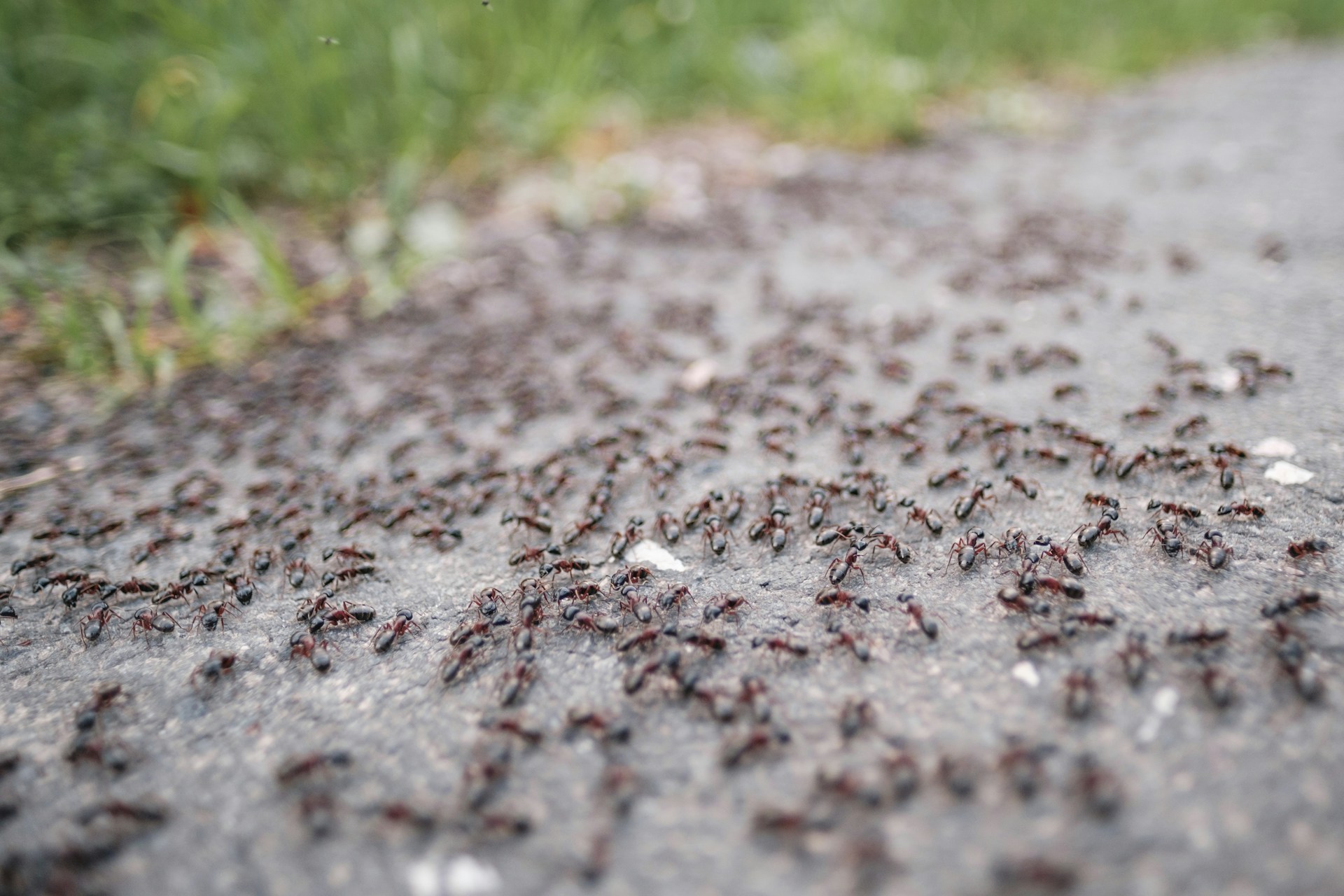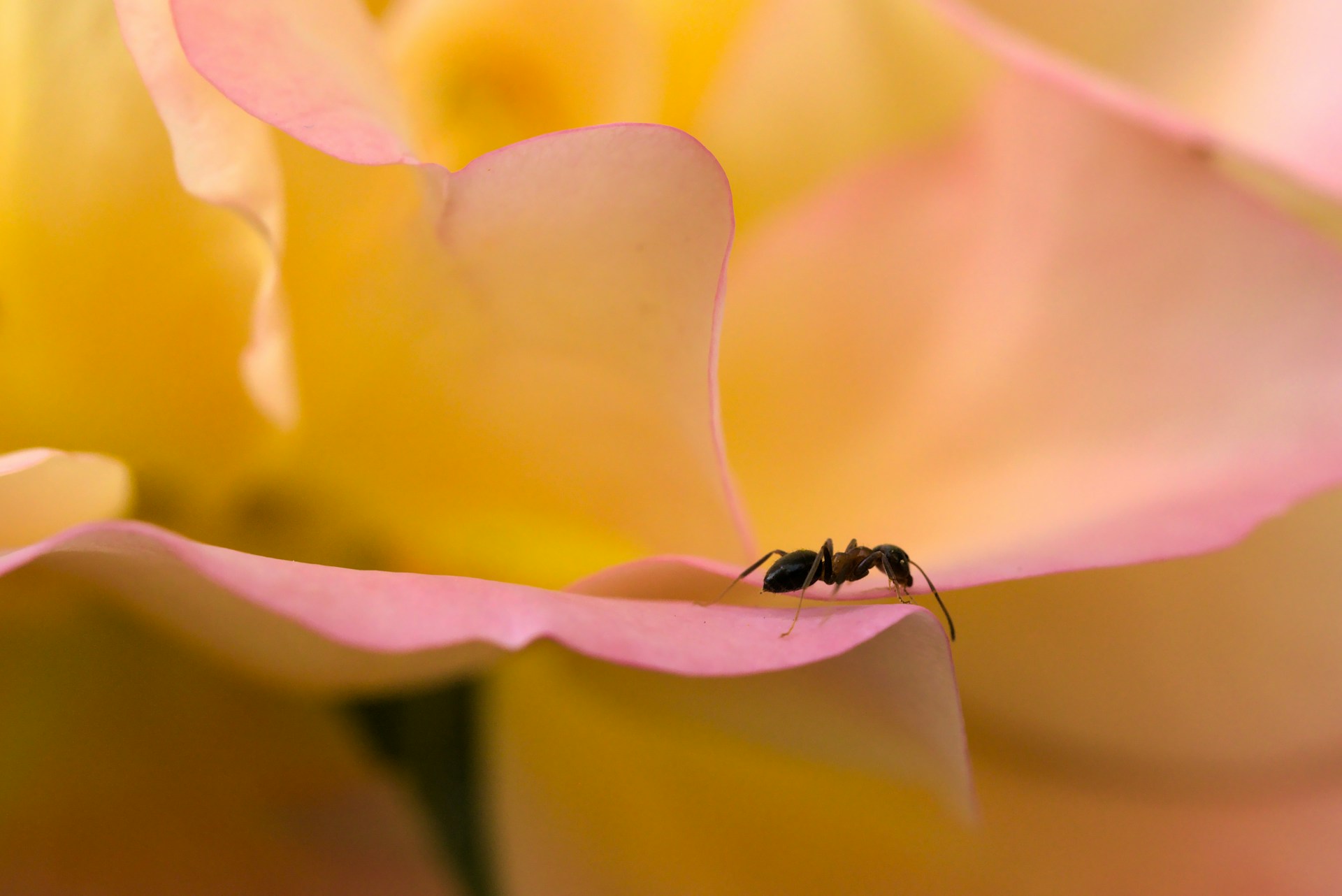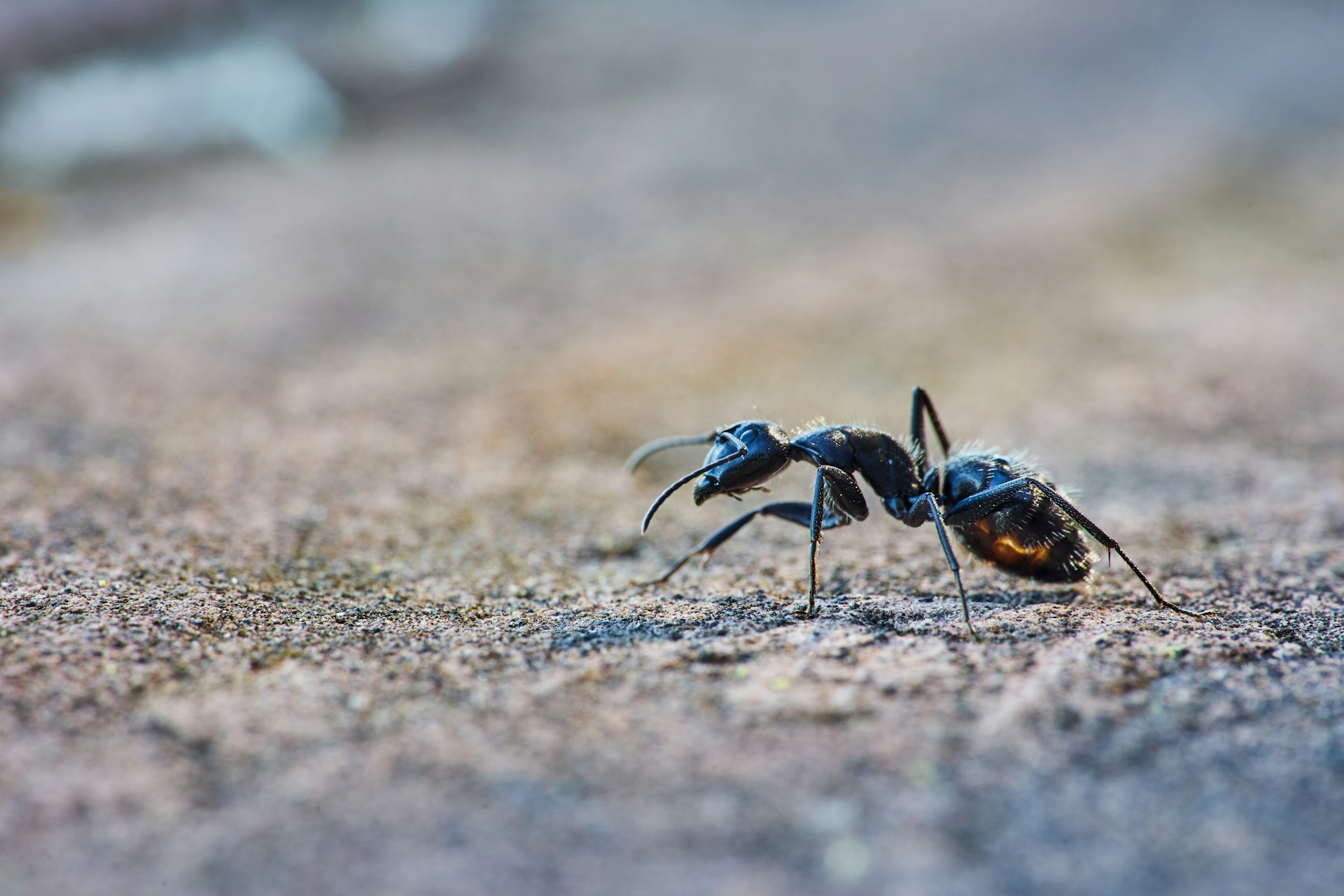
Window Treatment & Styles
How to Get Rid of Ants: A Strategic Approach that Works!
Ants are among the most common (and stubborn!) pests that invade Canadian homes. It may seem impossible to fully eliminate ants but don't worry: with the right strategy, you can wipe out the entire colony, not just the visible foragers!
In this guide, we'll explain exactly how to get rid of ants for good, how to prevent future infestations, and how to tackle the most persistent species!
Key Takeaways
- Start with bait, not spray. Spraying ant trails may feel satisfying, but it often makes infestations worse. Let worker ants carry slow-acting bait back to the nest to kill the colony from within.
- Prevention is critical. Keeping your surfaces clean, sealing entry points, and trimming outdoor vegetation are essential to stop ants from coming back after treatment.
- Different ants need different strategies. From sugar-loving black ants to wood-destroying carpenter ants, identifying the species helps you choose the most effective ways to kill ants.
Step-By-Step Guide: How to Get Rid of Ants
- Identify the ant trail. Follow the insects to see where ants enter from and where they’re going. This helps you locate entry points and place bait effectively.
- Don’t kill the foragers. Let a few ants continue their trail. These worker ants will carry poison bait back to the colony. Killing them too soon stops the process.
- Set out slow-acting bait. Use sweet gel or liquid bait (or protein-based if they ignore sugar). Place it near the trail, not randomly.
- Avoid sprays and cleaners. Do not spray insecticides or clean trails before baiting — this will only scatter the colony or make the bait ineffective.
- Remove food sources. It's important to make your house unattractive to ants.
- Be patient. It may take a few days to a few weeks for the bait to fully eliminate the colony. Replenish bait as needed.
- Seal entry points. Once ant activity drops off, seal cracks, wall gaps, and utility holes with caulk or foam to prevent re-infestation.
- Clean pheromone trails. After the ants are gone, wipe trails with soapy boiling water or vinegar to remove the scent markers they leave behind.
- Call a pro if needed. For persistent infestations, especially carpenter, Pharaoh, or Argentine ants, a professional exterminator may be needed to prevent structural damage.
Natural Deterrents that Can Help You Get Rid of Ants

Before discussing some natural products that can help you get rid of ants, we must mention that most of these natural remedies can repel or kill visible ants, but they rarely eliminate the entire colony. It is important to approach this process strategically to prevent ants from returning and finding new routes. See the section above for a step-by-step solution.
- Borax (Sodium Tetraborate): mix borax, sugar, and water; soak cotton balls and place them where ants are seen. Keep away from pets and children.
- Diatomaceous earth: sprinkle food-grade diatomaceous earth where ants travel. It dries out and kills ants by damaging their exoskeletons.
- Ground black or red pepper: sprinkle around baseboards and appliances to repel ants with a strong scent.
- Peppermint oil: mix peppermint essential oil with water and spray around entry points. Keep away from pets, especially cats.
- Tea tree oil: mix with water and spray, or use soaked cotton balls in ant-prone areas.
- Lemon eucalyptus oil: soak cotton balls and place them where ants are seen. Replace weekly. Do not ingest or allow access to children or pets.
- Cinnamon leaf essential oil: soak cotton balls and place them in ant-prone areas. Replace weekly. Keep away from pets.
- Neem oil: use full-strength neem oil around plants to repel ants and aphids. Less effective when diluted.
- Coffee grounds: sprinkle freshly brewed coffee grounds on disposable surfaces near ant activity. Replace when dry.
- Boric acid: mix with sugar and water, soak cotton balls, and place in ant areas. Can also be used in DIY traps. Keep away from pets and children.
- Lemons: use lemon juice to wipe surfaces and place lemon rinds in cupboards to mask food scents and deter ants.
How to Prevent Future Ant Infestations
Keeping ants out is far easier than eliminating them once they're inside. Prevention focuses on cutting off access, removing attractants, and discouraging nesting. In the following sections, we'll discuss these in detail.
1. Trim Plants and Trees Near Buildings
Ants often use branches and vines as natural bridges into your home. Therefore, trim shrubs, vines, and tree limbs that touch or overhang walls, roofs, or windows. Furthermore, remove mulch or heavy leaf litter near the foundation, because ants nest here and can easily find cracks to exploit.
2. Eliminate Food Sources and Maintain a Clean Perimeter
Ants are constantly foraging, and even tiny crumbs or spills can serve as an open invitation. Therefore:
- Store food in airtight containers.
- Clean up crumbs, pet food, and sugary spills (especially powdered sugar) immediately.
- Rinse recyclables before placing them in bins.
- Regularly empty garbage cans and compost bins, especially in warmer months.
- Regularly clean pet food dishes.
- Always clean up after cooking or eating outside.
- Remove standing water because ants love moisture.
- Avoid stacking firewood or debris against the home.
3. Clean Your Plants
Some ants, like the odorous house ants, eat the excretions of other bugs called aphids. Their excretions are known as honeydew, and they have high sugar concentrations. Honeydew can be found on both indoor and outdoor plants. If not cleaned regularly, they will eventually attract ants.
4. Seal Entry Points
Even the tiniest cracks and crevices can be an open door for ants. They typically enter homes through foundation cracks, wall gaps, utility penetrations, and underside voids near plumbing or wiring. Sealing these entry points is one of the most effective long-term defenses.
Here's how to seal ant entry points:
- Inspect the foundation: check for cracks where concrete meets siding or bricks.
- Seal gaps around pipes and wires: where utility lines enter your home (e.g., A/C lines, water pipes, dryer vents), use expanding foam or caulk to block ant-sized gaps.
- Baseboards and wall voids: ants sometimes travel inside walls. If you notice ant activity around baseboards or electrical outlets, use low-toxicity insecticidal dust inside voids, then seal them with caulk.
- Garage and basement edges: these areas often have gaps that go unnoticed.
5. Check Your Windows, Doors, and Bug Screens

Windows and doors are among the most common entry points for ants and other insects. They're also often overlooked because... they're closed, right? Well, slightly warped frames, worn-out weather stripping, or a torn bug screen can provide easy access for these pests. Therefore:
- Inspect all windows twice a year and check for signs of gaps and cracks.
- Re-apply caulking if you feel any drafts or see any cracks.
- Upgrade to energy-efficient, insulated window units if yours are old or warped.
- Pay special attention to basement and ground-level windows, which are more likely to be close to outdoor colonies.
- Install or replace door sweeps - even a tiny gap can let ants in.
- Ensure that sliding doors have tight-fitting tracks and use a bug strip where needed.
- Replace broken bug screens with high-quality insect screens with tight mesh.
For a sleek and functional upgrade, consider Magic's fully retractable bug screens. They are perfect for keeping bugs out without affecting a window's visibility too much. Our screens can stay hidden within their cartridge when not in use and pulled out when needed, covering the entire opening and leaving absolutely no gap behind for ants to sneak in!
How to Get Rid of Different Ant Species
While a general approach works for many ants, different species respond best to certain strategies. That's why correct identification is critical. Therefore, in the following sections, we'll have an in-depth discussion on how to recognize and handle the most common ant species that invade Canadian homes.
While there are over 100 species of ants in Canada, not all wander through houses. While all ants have elbowed antennae and thin waists, their behavior and diet preferences vary. As such, here are the most common ant species that can take residence in or around your home:
1. How to Get Rid of Carpenter Ants
Carpenter ants nest in wood, often inside walls or structural areas, which is why getting rid of them can be quite difficult.
Here's what may work:
- Find and remove the nest directly — they often ignore baits if nesting inside. This is the best way to get rid of carpenter ants. Look for outdoor nests as well, ideally 20 minutes after sundown, when ants will move up and down tree trunks.
- You can use a vacuum to remove the ants and destroy their nest.
- Alternatively, you can use dust insecticides (like diatomaceous earth or boric acid) in wall voids or directly into the nest. Make sure to follow label directions carefully and all safety precautions.
- Trim trees and replace or repair moisture-damaged wood to reduce re-entry.
- Avoid relying on bait alone without confirming where the nest is.
- Avoid using water-based or other formulations in wall voids.
2. How to Get Rid of Thief Ants
Thief ants are extremely small. They often nest near other ant colonies and steal their food. Thief ants are not attracted to sugary foods like other ants. The best way to deal with thief ants is to prevent them from entering your house in the first place.
Here's how you may be able to get rid of thief ants:
- Clean up any food sources.
- Do not use standard traps, as these ants are notoriously known for avoiding them. Thief ants also seem to be resistant to most insecticides.
- However, if you add a little oil or grease in the middle of the trap, they may take the bait. You can also mix household borax with cooking oil in a shallow dish.
- Use just enough grease to attract them - too much will limit the trap's effectiveness; too little will not attract them.
- Place the bait close to entry points and suspected nests.
- Seal small cracks and gaps — since they're tiny, thief ants can squeeze through almost anything.
3. How to Get Rid of Odorous House Ants

Odorous house ants are the easiest to control, especially if dealt with early. However, if you ignore the colony for a long period, its population will become larger and larger, and it may take weeks to get rid of all of them.
Here's what may work against odorous house ants:
- Remove all standing water, as they are attracted to moisture.
- Keep your house clean. Although odorous house ants primarily eat sugary foods, they can also eat greasy foods.
- Use sweet liquid or gel baits with slow-acting insecticide. You may have to try different types of baits because odorous house ants prefer certain types of foods depending on the season.
- Clean their trails with a mix of water and soap or vinegar after baiting, not before. Let the solution dry naturally.
- Use a properly labeled insecticide to treat the nest.
4. How to Get Rid of Pharaoh Ants
Pharaoh ants are tiny ants that form multiple colonies. Can you imagine that pharaoh ants can populate a large office block in less than six months? Because of this, controlling their population can be quite difficult - they can form small colonies that can survive extermination.
Here's what can help you get rid of pharaoh ants:
- Don't use insecticides to kill pharaoh ants. This will only cause the colonies to split, and they will reemerge later.
- Instead, use protein-based or sweet gel baits with a slow-acting ingredient.
- Place multiple bait stations in warm, hidden spots.
- Leave the ants alone after baiting. Don't kill foragers or disturb trails.
- Keep in mind that it can take weeks or even months to get rid of them completely.
5. How to Get Rid of Argentine Ants
Argentine ants form massive colonies with multiple queens. Because of this, they are very persistent invaders and quite difficult to get rid of.
Here's what may help you get rid of Argentine ants:
- Avoid using pesticides to get rid of Argentine ants, as they are known to stimulate increased egg-laying.
- Try borate-sucrose water baits.
- In spring, use protein-based baits, which may be more effective during a colony's growth phase.
6. How to Get Rid of Pavement Ants
Pavement ants are also known as sugar ants. They eat almost anything, including other insects. However, they rarely nest inside buildings, but they can enter homes if there are leftovers.
- Most often, it is enough to simply apply dish soap to a wet rag and wipe up the ants and their pheromone trails. This may stop others from entering the house.
- You may have to do this once or twice a day for up to a week to get rid of all of them.
- Alternatively, you can use a sweet, liquid bait with borax or boric acid.
- Replace the bait continuously until you stop seeing any ants. It can take around a week to completely eliminate them.
Summary: Do's and Don'ts for Fast Results
Looking for the Best Bug Screens to Keep Ants Out?
While baiting and sealing are essential for controlling ants, the first line of defense is blocking their entry altogether, especially through windows and doors. That's where Magic's innovative fully retractable screens come in!
Magic screens aren't just about airflow and visibility! They're engineered with tight-fitting seals and precision mesh that help prevent even the smallest insects, including ants, from sneaking in. Additionally, Magic windows and doors are manufactured with high-quality frames that won't warp or crack over time!
Want to see how Magic windows, doors, and screens can help keep your home pest-free? Contact us today to schedule a free consultation!
Frequently Asked Questions
How do you get rid of ants permanently?
To get rid of ants permanently, use slow-acting baits (like borax mixed with sugar) so foragers carry poison back to the colony, then seal entry points and maintain cleanliness to prevent re-infestation.
What scent will keep ants away?
Ants are repelled by strong scents such as peppermint, vinegar, lemon, tea tree oil, and black or red pepper; applying these around entry points can help keep ants away but likely won't damage their colonies.
Does vinegar and dawn kill ants?
Yes, a mixture of vinegar and dish soap (like Dawn) can kill ants on contact and disrupt their scent trails, but it won’t eliminate the entire colony.
What is the best home solution to kill ants?
The most effective home solution is a bait made from borax and sugar, which attracts ants and allows them to carry the poison back to the nest, killing the colony over time.
What kills ants instantly?
Pouring boiling water directly onto ant nests or using undiluted vinegar can kill ants instantly on contact, though this only affects visible ants and not the whole colony.
How to find out where ants are coming from?
Follow ant trails to locate entry points such as cracks, gaps, or holes near windows, doors, and plumbing; tracking their movement often leads you to their nest or the source of infestation.
How can I identify the type of ants in my home?
To identify the type of ants in your home, observe their size, color, and nesting habits, as these characteristics can help distinguish between species such as carpenter ants, odorous house ants, pavement ants, and pharaoh ants.
When should I consider professional pest control?
You should consider professional pest control if your ant infestation continues despite your DIY efforts or if you're dealing with a severe issue, like a carpenter ant infestation. It's essential to address significant pest problems promptly for effective resolution.
Are ant baits effective?
Ant baits are indeed effective, as they allow worker ants to transport the bait back to their colony, ultimately helping to eliminate the entire colony.